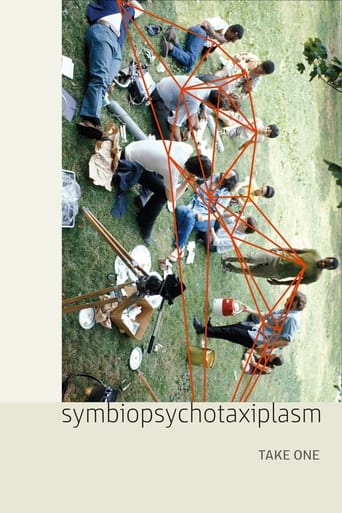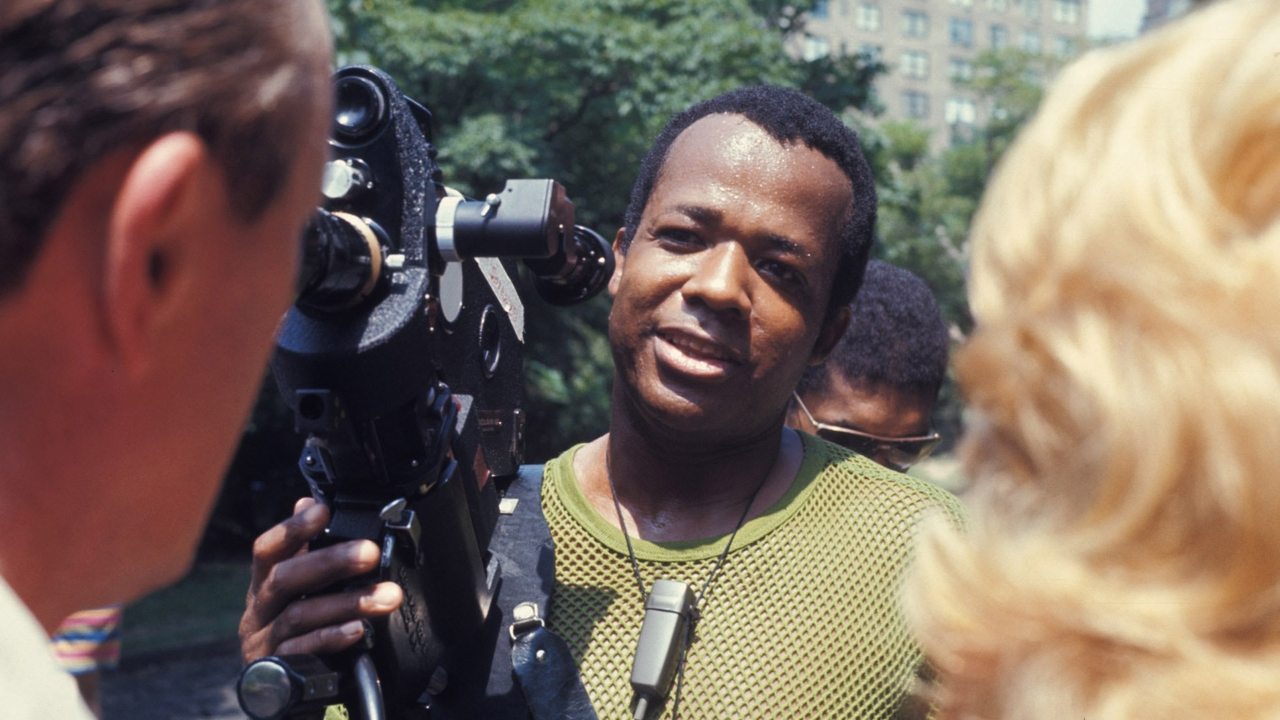Charles Herold (cherold)
This film is a real curiosity. It's the work of a successful documentary filmmaker who seems to have wanted to document what happens in a chaotic film production by creating a chaotic film shoot and then filming it.There are three camera crews, one to shoot a series of actors performing a two-person scene, one doing a basic "making of" style documentary that watches over the filming process, and a third crew there to film a more general making-of-the-making-of film.As the days go by, the camera crews become increasingly frustrated, unsure of what the director has in mind and wondering if they are possibly working on a disaster. They decide to film themselves discussing this, with arguments as to whether this is all part of the director's plan and whether, if it is, it's a good plan.It's certainly a different sort of documentary, but I didn't find it all that interesting. It's slow moving and wanders aimlessly.Is it, as some people feel, a profound meditation on reality? I found it hard to feel it is. What reality are we looking at? Actors struggling with bad dialogue? A crew frustrated by a lack of purpose and direction? These things might be interesting in a documentary of an actual movie, but this is more like one of those movies that tries to emulate bad movies and fails because it's too precious. The reactions provoked by someone trying to provoke reactions are closer in spirit to a TV reality series like Survivor than to something that tries to document a real situation.Like a lot of avant-garde filmmaking though, what you bring to this movie is more important than what this movie brings, which is why some people are blown away by it. I will say that I think the director got the movie he wanted, so it can be seen as a successful experiment. But I found it virtually unwatchable.
Bolesroor
Truth is what remains after we have rejected everything that is untrue.That is how we define our world, ourselves, our very reality. We are- whether we know it or not- constantly questioning, constantly searching for truth in our lives- from the most simplistic and straightforward to the universal eternal questions: the truth about love, and sex, and God, the truth about men and women, and the meaning of life. "Symbiopsychotaxiplasm" is a movie that brilliantly turns the medium of film- and its devices- into the ultimate litmus test of truth. That's all the movie is: the search for truth, experienced in multiple levels of reality and reflecting off itself in a series of mirrors.It's so much more simple than other reviewers make it sound. When critics start dusting off arcane technical descriptions and pretentious French terminology I usually run screaming in the opposite direction. William Greaves uses the simple idea of a film crew shooting a scene in the park as a departure point for a look at what is real. Is the scene real? Is it intentionally terrible? The absurd, stilted dialogue and over-the-top performances seem to suggest it's a smokescreen for something else, and yet there are times when the actors find Truth in the awful scene by transcending the premise and dialogue and reaching an emotional core. This is the very definition of acting, so in a strange way this zero-budget, atrociously-written scene succeeds more than many big-budget "legitimate" Hollywood films. But then Greaves includes footage of the actors as themselves rehearsing and discussing the scene
does seeing their actual personalities and hearing their own opinions enhance or detract from their performances? Or is this aspect of the film scripted as well? We don't know, and it's the absolute ambiguity that makes this movie magnetic and fascinating.The second level of the film is the behind-the-scenes documentary, which in many ways is the most pure form of cinema ever created. The camera captures the struggles and setbacks of the cast and crew on location, including intruding police officers, crowds of excited on-lookers, and even an eccentric homeless man to reveal the reality of what goes on during a shoot. The crew is frustrated, confused and almost mutinous over the director's seemingly careless attitude about the movie. It says a lot about Greaves' open-mindedness as an artist and a man that he's willing to include this footage that openly questions his talents and motivations. Clearly he's as willing to expose himself to scrutiny as his actors and his crew. That's commitment, and the key to the movie for me. The fact that Greaves included scenes that showed him in an unflattering light convinced me that the man is as pure a film artist as there ever was. Boldly, fearlessly, he stands completely vulnerable on screen in his own film and trusts the audience to judge him for themselves.The third level of the film is unprecedented and probably the most fun. Thirty years before the invention of DVD Director's Commentary the crew gathers and gives a running commentary on the movie- while it's still in production- and surprisingly questions whether or not the film has any value at all! Their passion is contagious... these are clearly all talented individuals who genuinely care about the project they're working on, and although they have different opinions they basically all arrive at the same conclusion: the movie is a disorganized mess. They're absolutely right, but few of them had the foresight to see that it's the sprawling, imperfect, fun-house atmosphere that makes it such a rich and rewarding experience.Just watching this movie will make you smarter about movies, if not life in general. It will make you question what you once blindly accepted, it will engage you and challenge you in a way that no other film ever has or probably ever will, and for that alone it is a tremendous success and exceptionally valuable. It is a time capsule of not only an era when artistic pursuits were much more nobly considered, but of a unique cinematic experience in which the audience, cast and crew all switch places like a magical game of musical chairs and in which the truth reveals itself to be just as maddeningly elusive as in real life.The first time I saw the film I was convinced the drunken homeless man who preaches to the crew was an actor playing a part in a staged segment of the behind-the-scenes documentary. The second time I saw it I was sure he was absolutely real.Let me know if you figure it out, won't you?GRADE: A
Michael_Elliott
Symbiopsychotaxiplasm: Take One (1968) *** (out of 4) Incredibly fascinating little gem from director William Greaves works as a feature film but also a documentary. Basically what we have here is Greaves shooting an actual feature dealing with a husband and wife fighting about their life while walking through Central Park. That's the "feature" side of things. While they're shooting this they also have two separate cameras picking up all the drama and action going on in real life. So, the film is one where we get to see the actual feature being shot but also a documentary covering the making of the actual movie. I can't say I had ever heard of this movie before it popped up on Turner Classic Movies but part of what makes being an open-minded film buff so great is that you often come across gems that you might not have had you simply didn't expand in your viewing habits. It's really hard to explain this feature or why it works so well but I found it to be rather fascinating because there are moments where we get a third aspect of the "film" which is when the production crew are gathered in a room where they discuss where the film should go and their opinions on whether or not Greaves is doing a good job directing. These three aspects of a "film" are so interesting that you have to wonder why someone didn't try doing a picture like this a lot earlier and while there are certainly some creaky moments, overall this is a rather genius thing to try and pull off and you really can't help but applaud the director. There are some very funny moments in the behind-the-scenes section including a bit where they're filming and a group of people gather to watch and the director has to explain to them what they're doing and why they need to be quiet so that they don't ruin the scene. There are other moments where the crew fight about how much film is left, there's a sequence with a cop wanting to see some permits and then of course there's the actual film being shot, which contains a couple actors who are very good in their parts. It's also interesting to see the actors playing their parts and coming up with ideas to run past the director. I think what I really pulled away from this movie, unlike any other documentary, is how everyone working on a film thinks they're the most important part. The actors are focused on their job. The director has his job. The crew have their job and everyone is so focused on what they're doing that it's hard to really see what the other person's job is and why it might be just as important. This movie certainly isn't for everyone but those who enjoy movies about making movies should find themselves entertained.
Polaris_DiB
How important is the director, anyway? In this film, made in the politically tumultuous times of the late 60s where questions of social organization were prime conflicts, asks that question by making a movie that turns the camera away from the action and only begs to reveal the director, William Greaves. It is an important work, as it shows like no other movie shows the difficulties in blocking, organizing, and setting the scene; it reveals the role of the crew, something most directors frankly would like to disappear completely and that the invisibility of is essential for suspending disbelief; and it also puts into consideration the role of performance and scripting and how they match/don't match reality and what that has to say about how the director ultimately influences reality (if at all).The documentary, or pseudo-documentary, or fictional narrative (whichever you prefer, via your interpretations of the themes) has its brain in the over-educated, over-intellectual crew, its guts in the lost performers struggling to understand the vague and ambiguous directions, and its heart in the director, who stands in as the desire to portray, to represent, to express without any idea how to do any of those things or why he wants to do it. It's a film that purposefully repeats banalities just to see if they can become more than banalities. It's a film that sometimes shows the multiple shots simultaneously, just to leave the editing to the audience and also reveal how disturbingly different shots change perspective.It's an important work, and something that everyone interested in the industry and process of film-making should watch and understand. It, like many experimental films, has no real mass-audience appeal--it's not for them. It's for the industry, and its for the 60s, asking what to do with a group-effort medium that still relies on a single "voice" and "author".--PolarisDiB


 AD
AD




